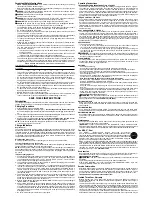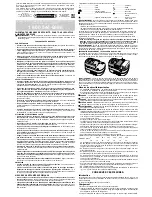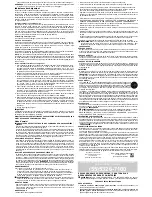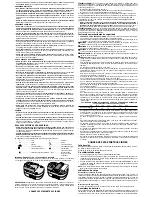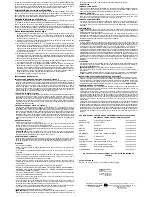
Important Safety Instructions
•
SAVE THESE INSTRUCTIONS. This manual contains important safety and operating
instructions for FSMVC battery charger.
•
Before using charger, read all instructions and cautionary markings on (1) charger, (2) bat-
tery pack, and (3) product using battery pack.
DANGER: 120 volts present at charging terminals. Do not probe with conductive objects.
Danger of electric shock or electrocution.
DANGER: If battery pack case is cracked or damaged, do not insert into charger. Danger of
electric shock or electrocution.
DANGER: Never attempt to open the battery pack for any reason. If the plastic housing of
the battery pack breaks or cracks, return to a service center for recycling.
WARNING: Don’t allow any liquid to get inside charger. Electric shock may result.
CAUTION: To reduce risk of injury, charge only Black & Decker rechargeable batteries.
Other types of batteries may burst, causing personal injury and damage.
•
To facilitate the cooling of the battery pack after use, avoid placing the charger or battery
pack in a warm environment such as in a metal shed, or an uninsulated trailer.
•
Do not expose charger to rain or snow.
•
Use of an attachment not recommended or sold by Black & Decker may result in risk of
fire, electric shock, or injury to persons.
•
This charger is not intended for any uses other than charging Black & Decker rechargeable
batteries. Any other uses may result in risk of fire, electric shock or electrocution.
•
To reduce risk of damage to electric plug and cord, pull by plug rather than cord when dis-
connecting charger.
•
Make sure cord is located so that it will not be stepped on, tripped over, or otherwise sub-
jected to damage or stress.
•
An extension cord should not be used unless absolutely necessary. Use of improper exten-
sion cord could result in risk of fire, electric shock, or electrocution. If an extension cord
must be used, make sure:
•
That the pins on plug of extension cord are the same number, size and shape of those
of plug on charger.
•
That extension cord is properly wired and in good electrical condition and the wire size
is large enough for AC ampere rating of charger as specified below.
An extension cord must have adequate wire size (AWG or American Wire Gauge) for safety.
The smaller the gauge number of the wire, the greater the capacity of the cable, that is, 16
gauge has more capacity than 18 gauge. When using more than one extension to make up
the total length, be sure each individual extension contains at least the minimum wire size.
RECOMMENDED MINIMUM AWG SIZE FOR EXTENSION CORDS
Total Extension Cord Length (feet)
25
50
75
100
125
150 175
Wire Gauge
18
18
16
16
14
14
12
•
The charger is ventilated through slots in the housing. Do not place any object on top of
charger or place the charger on a soft surface that might block the ventilation slots and
result in excessive internal heat. Place the charger in a position away from any heat source.
•
Do not operate charger with damaged cord or plug — have them replaced immediately.
•
Do not operate charger if it has received a sharp blow, been dropped, or otherwise
damaged in any way; take it to an authorized service center.
•
Do not disassemble charger; take it to an authorized service center when service or repair
is required. Incorrect reassembly may result in risk of electric shock, electrocution or fire.
•
The charger is designed to operate on standard120 VAC, 60Hz household electrical power.
Do not attempt to use it on any other voltage.
•
To reduce risk of electric shock, unplug charger from outlet before attempting any cleaning.
Removing the battery pack will not reduce this risk.
•
NEVER attempt to connect 2 chargers together.
•
DO NOT store or use the tool and battery pack in locations where the temperature may
reach or exceed 105°F (such as outside sheds or metal buildings in summer).
SAVE THESE INSTRUCTIONS
Introduction
Your charger is designed to use standard 120 volt AC, 60 Hz power. Do not use DC or any other
voltage. Charge time is 90 to 120 minutes depending on battery pack type and condition.
Charging Procedure
1. Plug the charger into an appropriate outlet.
2. Insert the battery pack into the charger (Fig.1) . Be sure the pack is fully seated in the charg-
er. The red (charging) light will blink continuously indicating that the charging process has start-
ed.
3. The completion of charge will be indicated by the red light remaining ON continuously. The pack
is fully charged and may be used at this time or left in the charger.
4. Unplug charger, and remove the battery pack. Place the battery in the tool and be cer-
tain that it is inserted fully into the tool cavity until it “clicks” into place.
NOTE: To remove the battery from the product, press down on the release button on the back
of the battery (Figure 2) and pull out.
Charge Indicators
Replace Pack:
The charger is designed to detect certain problems that can arise with battery packs which
would be indicated by the red light flashing at a fast rate. If this occurs, re-insert battery pack.
If problem persists, try a different battery pack to determine if the charger is OK. If the new pack
charges correctly, then the original pack is defective and should be returned to a service center
for recycling. If the new battery pack gives the same trouble indication as the original, have
charger tested at an authorized service center.
Wall Mounting (Figure 2A)
A hole is provided in the center of the charger for mounting on a vertical surface.
Leaving the Battery Pack in the Charger
The charger and battery pack can be left connected with the red light glowing indefinitely. The
charger will keep the battery pack fresh and fully charged.
NOTE: A battery pack will slowly lose its charge when kept out of the charger. If the battery pack
has not been kept on maintenance charge, it may need to be recharged before use. A battery
pack may also slowly lose its charge if left in a charger that is not plugged into an appropriate
AC source.
Important Charging Notes
1. Longest life and best performance can be obtained if the battery pack is charged when the
air temperature is between 65°F and 75°F (18°- 24°C). DO NOT charge the battery pack
in an air temperature below +40°F(+4.5°C), or above +105°F (+40.5°C). This is important
and will prevent serious damage to the battery pack.
2. The charger and battery pack may become warm to touch while charging. This is a normal
condition, and does not indicate a problem.
3. If the battery pack does not charge properly — (1) Check power at receptacle by plugging
in a lamp or other appliance. (2) Check to see if receptacle is connected to a light switch
which turns power off when you turn out the lights. (3) Move charger and battery pack to a
location where the surrounding air temperature is approximately 65°F - 75°F (18°- 24°C).
(4) If charging problems persist, take or send the tool, battery pack and charger to your
local service center.
4. The battery pack should be recharged when it does not produce sufficient power on jobs
which were easily done previously. DO NOT CONTINUE use under these conditions.
Follow the charging procedures. You may also charge a partially used pack whenever you
desire with no adverse affect on the battery pack.
5. Black & Decker battery packs that are labeled “NiMH” should only be used with chargers
labeled “NiMH“ or “NiCd/NiMH.”
6. Under certain conditions, with the charger plugged into the power supply, the exposed
charging contacts inside the charger can be shorted by foreign material. Foreign materials
of a conductive nature such as, but not limited to, steel wool, aluminum foil, or any buildup
of metallic particles should be kept away from charger cavities. Always unplug the charger
from the power supply when there is no battery pack in the cavity. Unplug charger before
attempting to clean.
7. Do not immerse charger in water or any other liquid.
Operating Instructions
TRIGGER SWITCH & REVERSING BUTTON - FIGURE 3
The drill is turned ON and OFF by pulling and releasing the trigger switch shown in Figure 3.
The farther the trigger is depressed, the higher the speed of the drill. A forward/reverse
control button determines the direction of the tool and also serves as a lock off button. To
select forward rotation, release the trigger switch and depress the forward/reverse control
button. To select reverse, depress the forward/reverse control button the opposite direction.
The center position of the control button locks the tool in the off position. When changing the
position of the control button, be sure the trigger is released.
TORQUE CONTROL - FIGURE 4
To set the tool’s torque, rotate the adjustable torque collar as required. There are 32 clutch
settings in all. These are indicated by numbers depicted on the torque collar. For light duty
work when using small screws, set the collar to the smallest number. Each click in a
clockwise direction means an increase in the torque produced. If the clutch slips on the
lightest setting, turn the clutch collar to a higher number. The highest position is the drill mode
and is indicated by a drill bit icon. In this position the clutch will not operate. This permits
heavy duty drilling.
DUAL RANGE GEARING - FIGURE 5
The dual range feature of your drill allows you to shift gears for greater versatility. To select
position 1, turn tool off and permit to stop. Push button forward towards the chuck. Position 1
is for driving and removing screws and drilling in non-hammer mode. To select position 2, turn
tool off and permit to stop. Slide gear shifter back (away from chuck). Position 2 is for drilling
with hammer action. NOTE: Do not change gears when tool is running. If you are having
trouble changing gears, make sure that the dual range gear button is either completely
pushed forward or completely pushed back.
KEYLESS CHUCK
To insert a drill bit or other accessory:
1. Grasp the rear half of the chuck with one hand and use your other hand to rotate the
front half in the counterclockwise direction, as viewed from the chuck end.
2. Insert the bit or other accessory fully into the chuck, and tighten securely by holding the
rear half of the chuck and rotating the front portion in the clockwise direction as viewed
from the chuck end.
WARNING:
Do not attempt to tighten drill bits (or any other accessory) by gripping the
front part of the chuck and turning the tool on. Damage to the chuck and personal injury may
occur when changing accessories.
SCREW DRIVING
For driving fasteners, the reversing button should be pushed to the left. Use reverse (button
pushed to the right) for removing fasteners. When moving from forward to reverse, or vice
versa, always release the trigger switch first.
DRILLING
• Use sharp drill bits only.
• Support and secure work properly, as instructed in the Safety Instructions.
• Use appropriate and required safety equipment, as instructed in the Safety Instructions.
• Secure and maintain work area, as instructed in the Safety Instructions.
• Run the drill very slowly, using light pressure, until the hole is started enough to keep the drill
bit from slipping out of it.
• Apply pressure in a straight line with the bit. Use enough pressure to keep the bit biting but
not so much as to stall the motor or deflect the bit.
• Hold the drill firmly with two hands to control its twisting action.
• DO NOT CLICK THE TRIGGER OF A STALLED DRILL OFF AND ON IN AN ATTEMPT TO
START IT. DAMAGE TO THE DRILL CAN RESULT.
• Minimize stalling on breakthrough by reducing pressure and slowly drilling through the last
part of the hole.
• Keep the motor running while pulling the bit out of a drilled hole. This will help reduce
jamming.
• Use a cutting lubricant when drilling metals. The exceptions are cast iron and brass which
should be drilled dry. The lubricants that work best are sulphurized cutting oil or lard oil.
• When using twist drill bits to drill holes in wood, it will be necessary to pull the bits out
frequently to clear chips from the flutes.
• Make sure switch turns drill on and off.
WARNING:
It is important to support the work properly and to hold the drill firmly to
prevent loss of control which could cause personal injury. If you have any questions on how to
properly operate tool, call: 1-800-54-HOW-TO (544-6986).
DRILLING IN WOOD
Holes in wood can be made with the same twist drill bits used for metal or with spade bits.
These bits should be sharp and should be pulled out frequently when drilling to clear chips
from the flutes.
DRILLING IN METAL
Use a cutting lubricant when drilling metals. The exceptions are cast iron and brass which
should be drilled dry. The cutting lubricants that work best are sulfurized cutting oil or lard oil.
DRILLING IN MASONRY
Use carbide tipped masonry bits. Refer to Drilling section. Keep even force on the drill but not
so much that you crack the brittle material. A smooth, even flow of dust indicates the proper
drilling rate.
Maintenance
Use only mild soap and damp cloth to clean the tool. Never let any liquid get inside the tool;
never immerse any part of the tool into a liquid.
IMPORTANT: To assure product SAFETY and RELIABILITY, repairs, maintenance and
adjustment (other than those listed in this manual) should be performed by authorized service
centers or other qualified service organizations, always using identical replacement parts.
The RBRC™ Seal
The RBRC™
(Rechargeable Battery Recycling Corporation)
Seal on the nickel-cadmium battery (or battery pack) indicates that the costs to
recycle the battery (or battery pack) at the end of its useful life have already been
paid by Black & Decker. In some areas, it is illegal to place spent nickel-cadmium
batteries in the trash or municipal solid waste stream and the RBRC program
provides an environmentally conscious alternative.
RBRC in cooperation with Black & Decker and other battery users, has established programs
in the United States and Canada to facilitate the collection of spent nickel-cadmium batteries.
Help protect our environment and conserve natural resources by returning the spent nickel-
cadmium battery to an authorized Black & Decker service center or to your local retailer for
recycling. You may also contact your local recycling center for information on where to drop
off the spent battery, or call 1-800-8-BATTERY.
Accessories
Recommended accessories for use with your tool are available from your local dealer or
authorized service center. If you need assistance regarding accessories, please call:
1-800-54-HOW-TO (544-6986).
WARNING:
The use of any accessory not recommended for use with this tool could be
hazardous.
The following accessories should be used only in the sizes specified below:
BITS, METAL DRILLING – Up to 3/8" (9.5mm); BITS, MASONRY DRILLING – Up to 3/8"
(9.5mm); WOOD DRILLING – Up to 1/2" (12.7mm).
Service Information
All Black & Decker Service Centers are staffed with trained personnel to provide customers
with efficient and reliable power tool service. Whether you need technical advice, repair, or
genuine factory replacement parts, contact the Black & Decker location nearest you. To find
your local service location, refer to the yellow page directory under "Tools—Electric" or call:
1-800-544-6986 or visit www.blackanddecker.com
Limited Three Year Warranty
Black & Decker (U.S.) Inc. warrants this product for three years against any defects in
material or workmanship. The defective product will be replaced or repaired at no charge in
either of two ways.
The first, which will result in exchanges only, is to return the product to the retailer from whom
it was purchased (provided that the store is a participating retailer). Returns should be made
within the time period of the retailer’s policy for exchanges (usually 30 to 90 days after the
sale). Proof of purchase may be required. Please check with the retailer for their specific
return policy regarding returns that are beyond the time set for exchanges.
The second option is to take or send the product (prepaid) to a Black & Decker owned or
authorized Service Center for repair or replacement at our option. Proof of purchase may be


